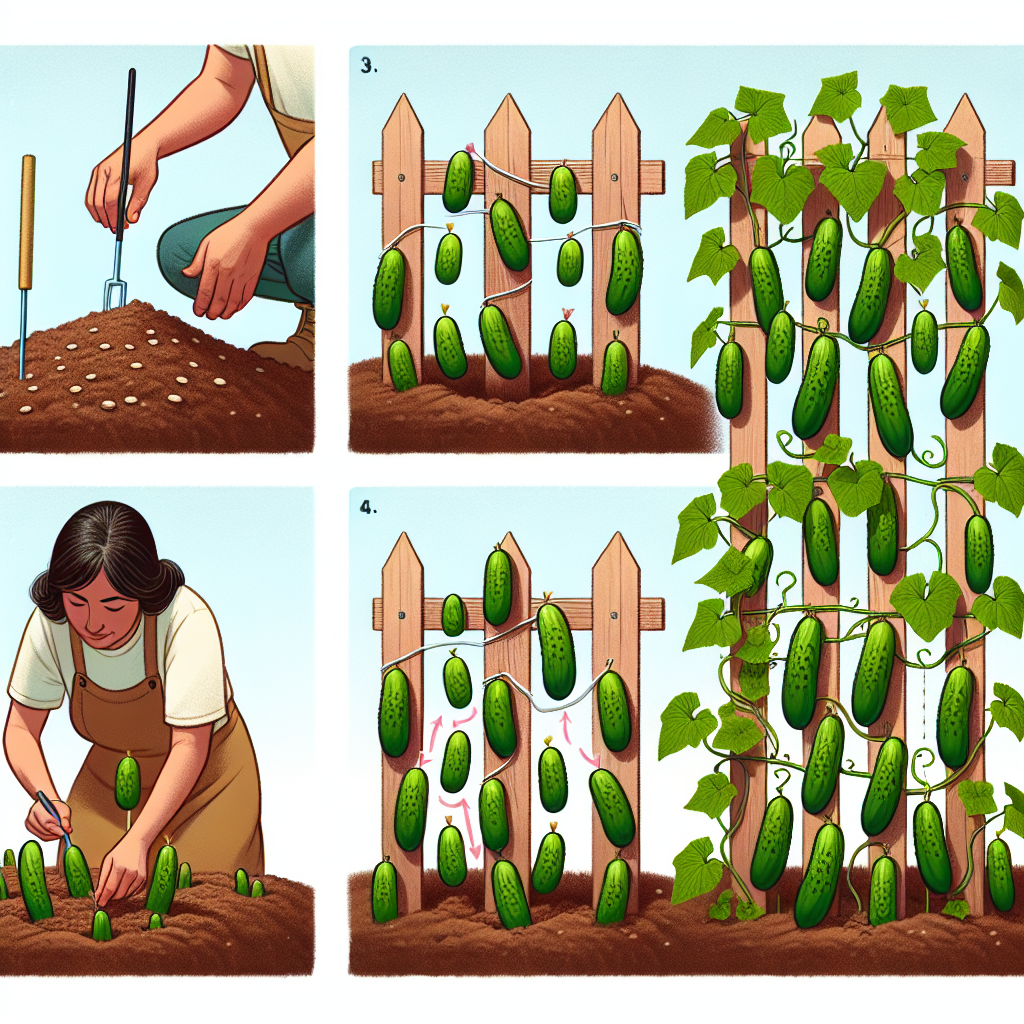
How to plant cucumbers to grow vertically
How to Plant Cucumbers to Grow Vertically: A Comprehensive Guide
Cucumbers are a favorite among gardeners for their crisp texture and refreshing taste. Not only are they delicious, but they also have a high yield and can be grown in various environments. One method that has gained popularity is growing cucumbers vertically. This technique saves space, allows for better air circulation, and can even lead to healthier plants. In this article, we will provide a detailed guide on how to plant cucumbers to grow vertically, from selecting the right variety to caring for your plants throughout the growing season.
Why Grow Cucumbers Vertically?
Growing cucumbers vertically comes with various advantages:
- Space-saving: Ideal for small gardens or container gardening.
- Improved air circulation: Reduces humidity and helps prevent diseases.
- Easy access: Makes harvesting and tending to the plants easier.
- Better sun exposure: Ensures that leaves receive adequate sunlight, leading to higher yields.
- Reduced pest issues: Elevating plants can deter certain pests from reaching them.
Choosing the Right Cucumber Variety
Before diving into how to plant cucumbers to grow vertically, it’s important to select the right variety. cucumbers generally fall into two categories: slicing and pickling. For vertical gardening, consider these factors:
- Vining vs. bush varieties: Vining varieties grow extremely well vertically and produce longer fruits, while bush varieties have a more compact growth and may not require vertical support.
- Disease resistance: Choose varieties that are resistant to common cucumber diseases such as powdery mildew and downy mildew.
- Growing season: Select a variety that matches your local growing conditions and season length.
Preparing to Grow Cucumbers Vertically
Setting Up Your Garden
Before planting, choosing the right location and preparing the soil is vital:
- Select a Sunny Location: Cucumbers love sunshine. Aim for a spot that gets at least 6-8 hours of direct sunlight daily.
- Soil Preparation: Cucumbers thrive in well-draining soil rich in organic matter. Amend your garden bed with compost or aged manure to enhance soil fertility.
- pH Level: Test the soil pH to ensure it's between 6.0 and 6.8. If necessary, amend your soil accordingly.
Choosing Support Structures
When growing cucumbers vertically, choosing the right support is essential:
- Trellis: A trellis can be made from wood, plastic, or metal. It should be sturdy enough to support the weight of the growing cucumbers.
- Wire Fencing: A section of wire fencing can serve as a great support structure.
- Netting: Garden netting attached to sturdy stakes can also work well.
How to Plant Cucumbers to Grow Vertically
Now that you have prepared your garden, you’re ready to plant your cucumbers. Here’s a step-by-step guide:
- Start Seeds Indoors: If you have a short growing season, consider starting seeds indoors 3-4 weeks before the last frost date.
- Direct Seeding Outdoors: If your area has a warm climate, sow seeds directly into the soil after the last frost date. Plant seeds 1 inch deep and 36 inches apart for the vining types, or follow package instructions for bush varieties.
- Transplant Seedlings: If you started seeds indoors, transplant seedlings outdoors once they have at least two true leaves and the soil has warmed up.
Caring for Your Vertical Cucumber Plants
To ensure a successful harvest, proper care is vital:
Watering
Cucumbers require consistent moisture to flourish. Follow these guidelines:
- Deep Watering: Water deeply at the base of the plants to encourage deep root growth.
- Mulching: Apply a layer of organic mulch to help retain soil moisture and suppress weeds.
- Avoid Wet Foliage: Water early in the day to prevent fungal diseases.
Fertilizing
To boost growth and yield, regularly fertilize your cucumber plants:
- Initial Fertilization: Use a balanced fertilizer when you transplant seedlings.
- Periodic Feeding: Side-dress with additional fertilizer every few weeks during the growing season.
Pest and Disease Management
Pest management is crucial for a healthy cucumber crop:
- Watch for Pests: Common pests include cucumber beetles and aphids. Utilize organic insecticides or remove pests by hand.
- Prevent Diseases: Ensure adequate airflow between plants and avoid overhead watering to mitigate the risk of diseases.
Harvesting Your Cucumbers
One of the most rewarding parts of gardening is harvesting your crops. Keep these points in mind:
- Timing: Cucumbers are typically ready for harvest 50-70 days after planting, depending on the variety.
- Size and Color: Harvest cucumbers when they are firm and bright green, typically around 6-8 inches in length.
- Regular Picking: Frequent harvesting encourages plants to produce more fruit.
Conclusion
Growing cucumbers vertically not only maximizes your space but also promotes healthier plants and easier harvesting. By understanding how to plant cucumbers to grow vertically, you can enjoy a plentiful harvest of fresh cucumbers throughout the growing season. Whether you're a novice or experienced gardener, this method is worth considering for your garden. So grab your seeds, build your trellis, and get ready to enjoy the delightful taste of homegrown cucumbers!
“The greatest gift of the garden is the restoration of the five senses.” – Hanna Rion
Don’t hesitate to share your experiences and tips in the comments below. Happy gardening!
By Guest, Published on October 2nd, 2024